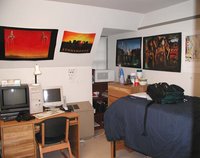Dormitory
|
|
A dormitory or dorm is a place to sleep. The word derives from the French 'dormir', to sleep.
Dormitories are usually referred to as 'dorms'. The word is used in two contexts:
- room with many beds (a sleeping dormitory);
- building with many small private rooms (a dormitory building);
| Contents |
Sleeping dormitory
A common usage of the term 'dormitory' is for a large room with many single beds. Examples are found in many rooming houses such as hostels, fraternities, sororities, and other scholarship halls. The room typically is a large room with very few furnishings except for beds. Such rooms can contain anywhere from 2 to 50 to hundreds of beds (though such very large rooms are rare except perhaps as military barracks). Such rooms provide little or no privacy for the residents, and very limited storage for personal items in or near the beds. Storage and personal spaces is often provided in other locations in the building, but these other locations are not usually called a 'dorm'.
Dormitory buildings
Usfbetahall.JPG
At boarding schools, colleges, and universities, the word dormitory is used to describe the entire building used to house students. It is this usage which is much more common in the United States. In UK Universities these buildings are usually called Halls of Residence. In the United States this terminology is often controversial at best among professionals and the term "residence hall" or simply "Hall".
Most colleges and universities provide (usually for a rental fee) single or multiple occupancy rooms for their students. These building are comprised of many such rooms, like an apartment building, and the number of rooms varies quite widely from just a few to hundreds. The largest dormitory building is Bancroft Hall at the United States Naval Academy
Formerly, many companies in the U.S. and elsewhere housed employees in dormitories. This practice has dwindled, but continues in many other countries.
Dormitories have replaced barracks at many U.S. military installations.
Typically, these dorm rooms are about 25 square meters (15 feet by 15 feet of floor space), and provide the following minimal furnishings:
- twin bed (sometimes in a bunk-bed configuration);
- desk;
- mirror;
- closet space (sometimes);
- drawers (clothes storage) (sometimes);
- window;
- sink with running water (rarely);
Most often, bathrooms are provided for a group of rooms, which provide shower, toilet, and sink facilities.
In the U.S., dormitories are most often segregated by gender, with men living in one group of rooms, and women in another. Some dorms are single-sex with varying limits on visits by persons of each gender.
Most dorms are much closer to campus than comparable private housing such as apartment buildings. This convenience is a major factor in the choice of where to live since living physically closer to classrooms means being able to sleep later and still arrive to class on time.
Examples
- University of Kansas, Lawrence Kansas, USA, Joseph R. Pearson Dormitory:
- Overall size: 6 floors of 36 rooms each (total 216 rooms approx.), typical population 380 (some people had single rooms);
- Room: 15 x 15 ft. square, 3 feet was a dual closet, with built in drawers, and lighted mirror alcove;
- Contents: Single-sized bed which folded into a couch (or bunk beds, by choice), desk, lamp (no sink);
- Bathrooms: One bathroom for 18 rooms, containing 5 shower stalls, 8 sinks, 4 toilets, and 3 urinals;
- Genders: Single sex dorm (for men), though in summer had men in one wing and women in the other;
- Extras: Cafeteria in basement, workout room, laundry room, elevators, lobby, music / piano room, game room;
- College of St. Catherine, St. Paul, Minnesota, USA, Stanton Hall Dormitory:
- Overall size: 3 floors with a total of 29 rooms;
- Room: 14 x 14 ft. square, 3 feet dual closet, lighted mirror alcove with built in drawers;
- Contents: Single-sized bed, desk, lamp (no sink);
- Bathrooms: One bathroom for 20 rooms;
- Genders: Single sex dorm (for women);
- Extras: Campus-wide cafeteria in another building, one 'kitchen/rec room' per floor, laundry, lobby / meeting room.
The largest dormitory on the eastern half of the United States is Clara Dickson Hall at Cornell University. This freshman dorm can house over 1000 students.
Housekeeping
University dorms have housekeeping staff to maintain the cleanliness of common rooms including lobbies and bathrooms. Stereotypically, college dorm rooms are small and messy; this stereotype has a strong basis in fact.
Disambiguation
The term dormitory is also often applied to suburbs or towns adjacent to large cities. For instance, Porirua is a dormitory city for Wellington, New Zealand. (In the United States, these would be called bedroom communities, and they are also referred to in some countries as commuter towns.)


